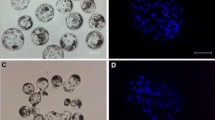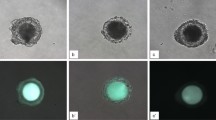Abstract
Objective
To examine the effect of SU9516, a cyclin-dependent kinase inhibitor, on the induction of tetraploid blastocyst formation in porcine embryos by parthenogenetic activation.
Results
Karyotype analysis of blastocysts showed that in the SU9516-treatment group 56% were tetraploid, whereas in the cytochalasin B (CB) group 67% were diploid. The level of maturation-promoting factor (MPF) in stimulated embryos treated with 10 µM SU9516 for 4 h was lower than in embryos treated with CB group (103 vs. 131 pg/ml). The mRNA expression levels of Nanog significantly increased in SU9516-treated embryos than CB group.
Conclusion
SU9516 can induce tetraploid blastocyst formation at high efficiency. SU9516 can significantly influence the in vitro developmental competence of porcine parthenogenetically activated embryos by influencing the level of MPF and the gene related apoptosis and pluripotency.




Similar content being viewed by others
References
Bromhall JD (1975) Nuclear transplantation in the rabbit egg. Nature 258:719–722
Eakin GS, Behringer RR (2003) Tetraploid development in the mouse. Dev Dyn 228:751–766
Fukusumi Y, Naruse C, Asano M (2008) Wtap is required for differentiation of endoderm and mesoderm in the mouse embryo. Dev Dyn 237:618–629
Funahashi H, Cantley TC, Day B (1997) N Synchronization of meiosis in porcine oocytes by exposure to dibutyryl cyclic adenosine monophosphate improves developmental competence following in vitro fertilization. Biol Reprod 57:49–53
Gao S, Wen X, Yang R, Di K, Tong J, Li X (2008) Decreased surfactant protein B expression in mice derived completely from embryonic stem cells. In Vitro Cell Dev Biol Anim 44:10–16
Kang L, Wang J, Zhang Y, Kou Z, Gao S (2009) Ips cells can support full-term development of tetraploid blastocyst-complemented embryos. Cell Stem Cell 5:135–138
Keezer SM, Gilbert DM (2002) Sensitivity of the origin decision point to specific inhibitors of cellular signaling and metabolism. Exp Cell Res 273:54–64
Kellogg DR (1989) Centrosomes. Organizing cytoplasmic events, Nature 340:99–100
Lane ME, Yu B, Rice A, Lipson KE et al (2001) A novel cdk2-selective inhibitor, su9516, induces apoptosis in colon carcinoma cells. Cancer Res 61:6170–6177
Liu L, Kong N, Xia G (2013) Molecular control of oocyte meiotic arrest and resumption. Reprod Fertil Dev 25:463–471
Lowthert L, Leffert J, Lin A, Umlauf S et al (2012) Increased ratio of anti-apoptotic to pro-apoptotic Bcl2 gene-family members in lithium-responders one month after treatment initiation. Biol Mood Anxiety Disord 2:1–11
Pfeiffer MJ, Stehling M, Jauch A, Boiani M (2012) ES cell lines from tetraploid mouse blastocysts. Adv Stem Cell Res 2012:1–16
Pines J (1999) Four-dimensional control of the cell cycle. Nat Cell Biol 1:73–79
Snow MH (1973) Tetraploid mouse embryos produced by cytochalasin B during cleavage. Nature 244:513–515
Somfai T, Hirao Y (2011) Synchronization of in vitro, maturation in porcine oocytes. Methods Mol Biol 761:211–225
Ulloa Ulloa CM, Yoshizawa M, Yamashita A, Hama S, Mitsui A, Hashi C, Abe H, Hoshi H, Fukui E, Matsumoto H (2008) Blastocyst production from in vitro-produced day-2 bovine embryos classified by cleavage stage, and cytogenetical evaluation of the resultant day-8 blastocysts. J Reprod Dev 54:465–472
Webster DR (2002) Microtubules in cardiac toxicity and disease. Cardiovasc Toxicol 2:75–89
Wen D, Saiz N, Rosenwaks Z, Hadjantonakis AK, Rafiiet S (2014) Completely ES A novel cdk2-selective inhibitor, SU95cell-derived mice produced by tetraploid complementation using inner cell mass (ICM) deficient blastocysts. PLoS ONE 9:e94730
Acknowledgments
This work was supported by the State Key Development Program for Basic Research of China (Grant No. 20150622005JC) and the institute for Basic Science (Grant No. IBS-R021-D1-2015-a02). Guo Qing is greatly indebted to his thesis supervisor, Dr. Yin Xi-Jun and Dr.Kang Jin-Dan.
Supporting information
Supplementary Table 1—Primer sequences used for gene expression analysis.
Author information
Authors and Affiliations
Corresponding author
Additional information
Qing Guo and Long Jin contributed equally to this study.
Electronic supplementary material
Below is the link to the electronic supplementary material.
Rights and permissions
About this article
Cite this article
Guo, Q., Jin, L., Zhu, HY. et al. CDK inhibitor SU9516 induces tetraploid blastocyst formation from parthenogenetically activated porcine embryos. Biotechnol Lett 39, 951–957 (2017). https://doi.org/10.1007/s10529-017-2321-6
Received:
Accepted:
Published:
Issue Date:
DOI: https://doi.org/10.1007/s10529-017-2321-6




